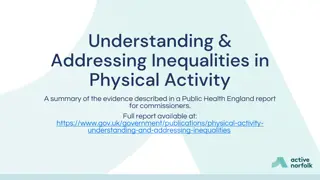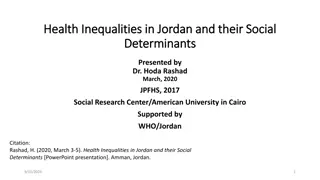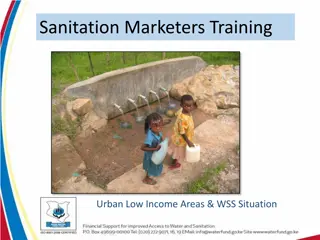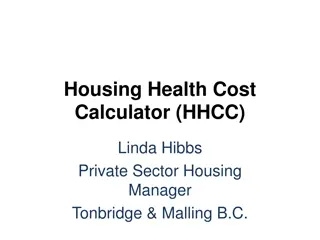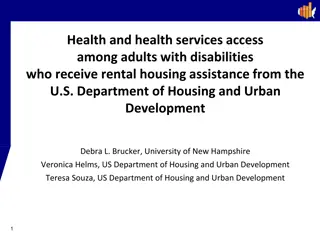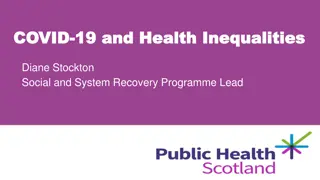Understanding Housing, Health, and Inequalities in Urban Environments
Evaluating the intricate relationship between housing, health, and social determinants in urban settings is crucial for addressing health disparities and promoting well-being. The conditions of one's home directly impact their physical and mental health outcomes, highlighting the need for creating supportive environments for all individuals. By acknowledging the role of housing in shaping health inequalities, we can work towards fostering healthier and more equitable communities.
Download Presentation

Please find below an Image/Link to download the presentation.
The content on the website is provided AS IS for your information and personal use only. It may not be sold, licensed, or shared on other websites without obtaining consent from the author. Download presentation by click this link. If you encounter any issues during the download, it is possible that the publisher has removed the file from their server.
E N D
Presentation Transcript
A tale of two cities Housing, Health and Health Inequalities Stephen Battersby MBE PhD FCIEH FRSPH
Good health starts at home The home is the main setting for our health throughout our lives it is fundamental to our health Housing is a social determinant of health - the conditions in which people are born, grow, live, work and age, including the health system (Marmot)
Good health starts at home Social determinants of health are mostly responsible for health inequities - the unfair and avoidable differences in health status Persisting inequalities across key domains underscore this Inequalities in early child development & education, employment & working conditions reflect housing & neighbourhood conditions which also affect affect mental health
A health map for the local human habitat Source: Barton H & Marcus Grant M, 2006, JRSPH, 126 (6)
Number of people killed or injured by location Per year UK Killed Injured At work 380 1,500,000 On the road 3,600 317,000 At home 4,100 2,700,000 Source: WHO Europe 2005
Housing and Health DWELLING the physical structure providing shelter, the necessary space, facilities and amenities for the household. Unsatisfactory conditions may lead to one or more direct health effects (WHO)
Housing and Health HOME - the social cultural and economic structure created by the household, representing a refuge from the outside & enabling the development of a sense of identity; any intrusion of external factors or stressors limits the feeling of safety etc (WHO)
Some issues Housing condition direct and indirect effects Cost of housing - increasing debt and reduced ability to have control over one s life (increasing health inequality) Security tenure relevant & frequent moves in PRS not conducive to stable home life psychological stress (& end of AST most common reason for homelessness (32%) the defining characteristic (NAO)) Local environment no green space, poor air quality, noise, crime
Homelessness 65,000 families, 125,00 children currently homeless More than 300,000 people in Britain sleeping rough or in temporary accommodation Temporary accommodation often not properly assessed & can be hazardous Children in temporary accommodation for > one year 3x more likely to demonstrate mental ill health Moving home many times in early life affects child behaviour and mental health (Shelter)
House to be used for homeless family (roof space converted to two bedrooms) Open riser stair (of varying heights) to first floor from behind rear door in kitchen area of single ground floor room + irregular tread at top step & ranch style climbable guarding
Dampness Dampness is more likely to occur in houses that are overcrowded and lack appropriate heating, ventilation and insulation (Institute of Medicine 2004), The prevalence of indoor damp in low-income communities can be substantially higher than the national average (WHO Guidelines for Indoor Air Quality - Dampness and Mould, WHO, 2009) A damp home is also more likely to be a cold home
Cold Direct impacts Excess winter deaths 3x higher in coldest quarter than warmest quarter; 40% attributable to cardio-vascular disease &33% attributable to respiratory disease Children - >2x more likely to have respiratory problems Adolescents >1 in 4 at risk of multiple mental health problems (1 in 20 in warm homes) Increased COPD, & cardio vascular diseases Mental ill-health Arthritis & rheumatism exacerbated (IHE, UCL)
Cold Indirect impacts Cold homes negatively affects children s educational attainment & emotional wellbeing & resilience family dietary opportunities and choices (to eat or heat dilemma) dexterity: increases risk of accidents & unintentional injuries Time off work and loss of earning for occupiers as the result of ill-health (reinforcing poverty & health inequity) (IHE, UCL)
(Over)crowding & Lack of space Adverse effects on children include negative educational performance and behaviour (Ambrose & Farrell 2009) Children up to 10 times more likely to contract meningitis(Harker 2006) Overcrowding linked to spread of TB (in 2011 there were 8,963 cases reported (HPA) Increase risk of accidents & unintentional injuries
Housing Health and Safety Rating System (HHSRS) Underlying principle - a means of comparing different hazards arising from deficiencies and of reflecting the seriousness of these as identified by the surveyor or building manager on inspection It is NOT a standard it is a means of assessing dwellings (not actually enforced but underpins any action by local housing authority)
The HHSRS principles Any residential premises should provide a safe and healthy environment for any potential occupier (or visitor) Dwelling unit (letting) should be capable of providing adequate protection from all potential hazards prevailing in local external environment Some hazards inevitable but risks should be minimised
The HHSRS principles A dwelling that is safe & healthy for the vulnerable age group will be safe and healthy for all It is the effects of deficiencies that are important not the deficiencies themselves the HHSRS is solely about risks to health and safety
Potential Housing Hazards Arranged into four groups - A - Physiological Requirements B - Psychological Requirements C - Protection Against Infection D - Protection Against Accidents
Potential Housing Hazards A - Physiological Requirements Pollutants (non-microbial) Asbestos (and MMFs) Biocides Carbon Monoxide etc Lead Radiation Uncombusted Fuel Gas Volatile Organic Compounds Hygrothermal Conditions Damp and Mould Growth Excess Cold Excess Heat
Potential Housing Hazards B - Psychological Requirements Space, Security, Light & Noise Crowding and Space Entry by Intruders Lighting Noise
Potential Housing Hazards C - Protection Against Infection Hygiene, Sanitation & Water Supply Domestic Hygiene, Pests and Refuse Food Safety Personal Hygiene, Sanitation & Drainage Water Supply for Domestic Purpose
Potential Housing Hazards D - Protection Against Accidents Collisions, Cuts and Strains Collision & Entrapment Explosions Position and operability of amenities Structural Collapse & Falling Elements Falls Falls associated with baths etc Falling on the level Falling associated with stairs and steps Falling between levels Electric Shocks, Fires, Burns & Scalds Electrical Hazards Fire Flames and Hot Surfaces etc
Deficiencies & Hazards One deficiency could give rise to more than one hazard disrepair to a door and frame & self-closer could give rise to Entry by Intruders Noise Excess Cold (draughts) Domestic Hygiene Pests & Refuse depending on the location and nature of disrepair Many deficiencies could give rise to only one hazard mould in the bathroom, penetrating damp under to window and through the ceiling all contribute to Damp & mould - single hazard rated once, but greater exposure greater risk
Relating People & Hazards Potential hazards are assessed in relation to the most vulnerable class of person (by age) who might typically occupy or visit the dwelling, regardless of who actually occupies e.g. ~ potential hazard from gaps in banisters judged in terms of young child The principle is that if a dwelling is safe or healthy for the most vulnerable then it will be safe for all
Harm is: The possible health outcome(s) from an occurrence, whether temporary or permanent. That is, the adverse physical or mental effect on the health of a person, such as physical injury, illness, or other health condition or symptom that would justify medical attention
Hazard rating Identified hazard is rated by a formula that takes account of: 1. Likelihood or probability of an occurrence (event or exposure that could cause harm) over next 12 months 2. Percentage spread of possible harm outcomes, from extreme to moderate The formula produces a hazard score or rating
Part 1 Housing Act 2004 Enforcement by local authorities Category 1 Hazards (Bands A C or Hazard rating of 1000 or more) duty on LHA to take the most appropriate enforcement action in Part 1 Housing Act 2004 Category 2 Hazards (Bands D J or Hazard rating of 999 or less) power on LHA to consider action
Points to note Hazard arises from deficiencies and is rated by reference to the vulnerable age group where this has been identified, regardless of actual occupation (an empty property could be rated) The actual occupation will be taken into account when the LHA considers which if any course of action under Part 1 of Housing Act 2004 e.g. Hazard Awareness, Improvement Notice or Prohibition Order etc
Local authority action 2015-16, 4.5 million households were renting in the private sector (second largest tenure) 28% of private rented homes failed to meet the Decent Homes standard (0.795m with any Cat 1 hazard 0.229m Excess Cold) Evidence is many local authorities not using their powers effectively; in 2013/14 Median no. Improvement Notices = 6 Median no. Prohibition Orders = 1
Cost of poor housing The HHSRS Formula allows an assessment of the costs of poor housing to be made as harm outcomes can be monetised although exported or social costs not included Costs & benefits to the NHS of reducing Cat 1 Hazards to acceptable level Total cost of remedial action ( ) No. Cat 1 hazards Savings to NHS p.a. ( ) Payback period Country England 4,752,000 17.6bn 602m 29.3 Wales 363,433 1.5bn 67m 22.9 N. Ireland 144,458 0.4bn 33m 12.8 Scotland 458,434 1.5bn 58m 26.4
Costs and savings for some Cat 1 hazards Hazard Av remedial cost per dwelling ( ) Total cost to remedy ( bn) Savings to NHS p.a. if hazard remedied ( bn) Payback (years) Excess Cold 4,574 6.061, 0.848 7.14 Falling on stairs 857 1.159 0.207 5.60 Falling on level 780 0.424 0.127 3.32 Dampness 7,382 0.394 0.015 25.27 Noise CO 1,411 506 0.008 0.008 0.0018 0.0015 4.96 5.21 Fire 128,590 0.46 0.025 18.62
Costs to NHS of all homes with significant HHSRS hazards No dwellings % Housing Stock Cost to NHS p.a. ( ) Homes with 1+ Cat 1 hazard 3,472,765 15.3 1.413bn Homes with 1+ Cat 2 (rated >500) Hazard but no Cat 1 2,476,655 10.9 428m Homes with worse than average Hazard (<500) but no Cat 1 2,433,939 10.7 160m Homes with significant hazards (any of above) 8,383,359 36.9 2.0bn All housing in England 22,718,266 100 -
Housing and other health hazards Risk Factor Total cost burden to NHS p.a. Physical inactivity 0.9- 1bn Overweight/obesity 5.1- 5.2bn Smoking 2.3- 3.3bn Alcohol 3.2- 3.2bn Housing 1.4- 2.5bn Source: Nicol, Roys & Garrett The cost of poor housing to the NHS, PHE Briefing Paper
Thank You Any Questions?






